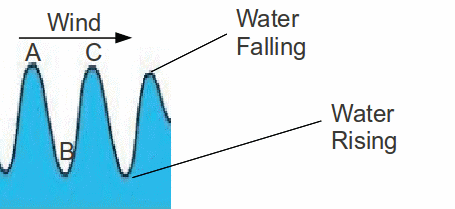Most water waves are formed as a result of changes in the pressure and velocity of air close to the water surface. The largest waves are however formed by tides, currents, earthquakes etc. Increasing windspeed is associated with increasing wave height. Assuming that the wind mainly exerts pressure on the windward slope of water below, the wind pressure on the water between B and C is greater than between A and B.

The wind increases the water movement in the wave and so transfers energy to it, the wind weakening a little in the process, with the strengthening or weakening depending on the relative speed. Waves travelling in the same direction of the wind will get larger and those travelling against the wind will get smaller. The above holds for waves travelling slower than the wind.
It is observed that shorter wavelength waves travel slower than longer wavelength waves (speed is an increasing function of wavelength) and can more quickly obtain energy from a favourable wind. Waves with shorter wavelength are more likely to dissipate energy in the form of turbulence and foam. Longer wavelength waves are more likely to retain energy, and these tend to predominate in open water. Typical North Atlantic waves have a period of 7 seconds, wavelength of 70 meters and speed of 10 m/s with occasional waves up to 200m long having speeds of 17 m/s. In the Pacific – a much larger area – waves 300m long travelling at 25 m/s are common.
Attenuation of the water due to the water having viscosity only has a significant affect after the wave has travelled around the Earth a couple of times, so can be ignored for the most part, since a land mass will have been encountered before then, hence long waves can travel right across an ocean.
